Report for Volkswagen Company in Germany & China
VerifiedAdded on 2023/06/04
|20
|4816
|212
AI Summary
This report scrutinizes the operations of Volkswagen Company in both its headquarters at Germany and one of its main branches in China. The report will also make an extra mile to examine the macroeconomic environments in the two countries, Germany & China and determine how they might affect the company’s progress in the near future.
Contribute Materials
Your contribution can guide someone’s learning journey. Share your
documents today.

Running Head: REPORT FOR VOLKSWAGEN COMPANY, GERMANY & CHINA 1
REPORT FOR VOLKSWAGEN COMPANY, GERMANY & CHINA
Student Name
Institution Affiliation
Facilitator
Course
Date
Table of Contents
REPORT FOR VOLKSWAGEN COMPANY, GERMANY & CHINA
Student Name
Institution Affiliation
Facilitator
Course
Date
Table of Contents
Secure Best Marks with AI Grader
Need help grading? Try our AI Grader for instant feedback on your assignments.
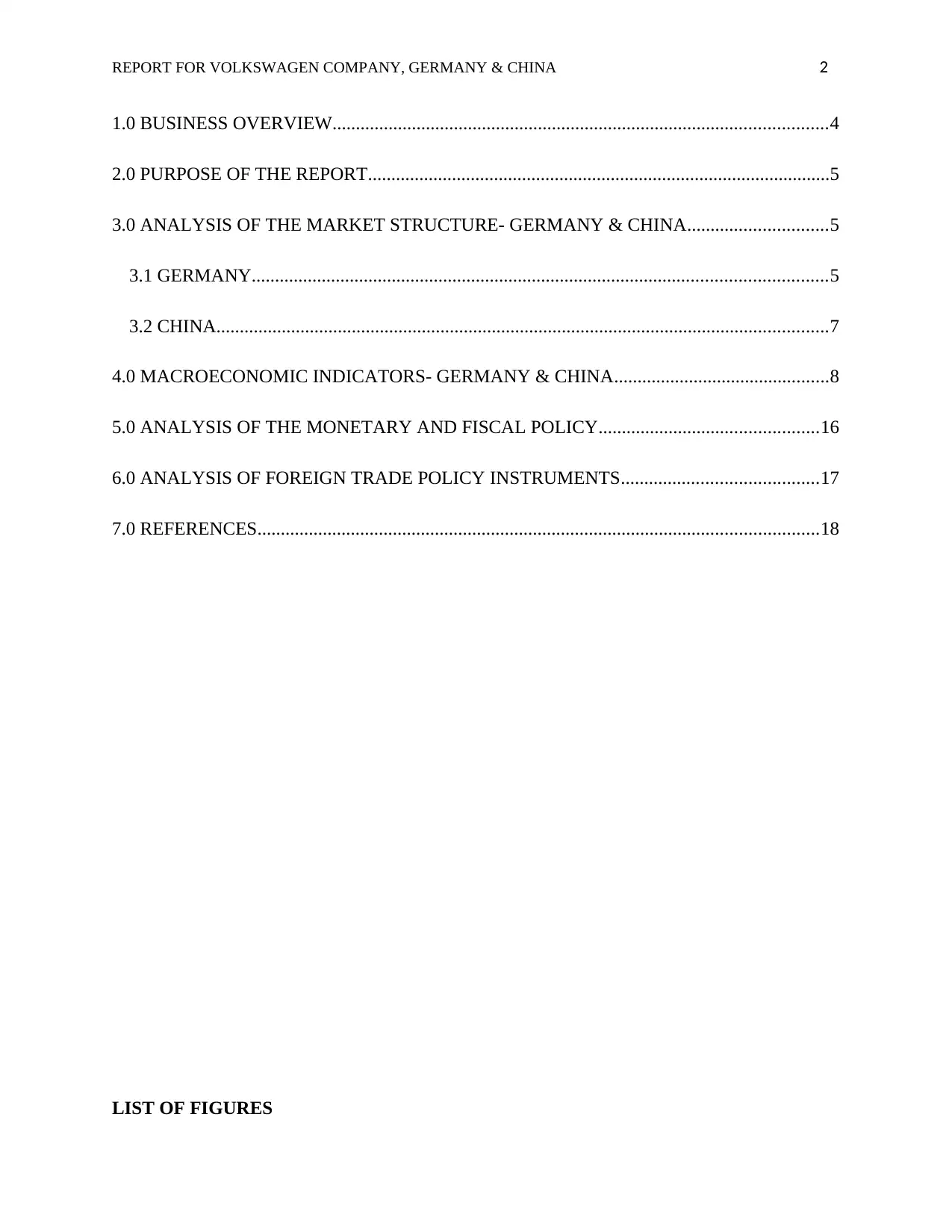
REPORT FOR VOLKSWAGEN COMPANY, GERMANY & CHINA 2
1.0 BUSINESS OVERVIEW..........................................................................................................4
2.0 PURPOSE OF THE REPORT...................................................................................................5
3.0 ANALYSIS OF THE MARKET STRUCTURE- GERMANY & CHINA..............................5
3.1 GERMANY...........................................................................................................................5
3.2 CHINA...................................................................................................................................7
4.0 MACROECONOMIC INDICATORS- GERMANY & CHINA..............................................8
5.0 ANALYSIS OF THE MONETARY AND FISCAL POLICY...............................................16
6.0 ANALYSIS OF FOREIGN TRADE POLICY INSTRUMENTS..........................................17
7.0 REFERENCES........................................................................................................................18
LIST OF FIGURES
1.0 BUSINESS OVERVIEW..........................................................................................................4
2.0 PURPOSE OF THE REPORT...................................................................................................5
3.0 ANALYSIS OF THE MARKET STRUCTURE- GERMANY & CHINA..............................5
3.1 GERMANY...........................................................................................................................5
3.2 CHINA...................................................................................................................................7
4.0 MACROECONOMIC INDICATORS- GERMANY & CHINA..............................................8
5.0 ANALYSIS OF THE MONETARY AND FISCAL POLICY...............................................16
6.0 ANALYSIS OF FOREIGN TRADE POLICY INSTRUMENTS..........................................17
7.0 REFERENCES........................................................................................................................18
LIST OF FIGURES
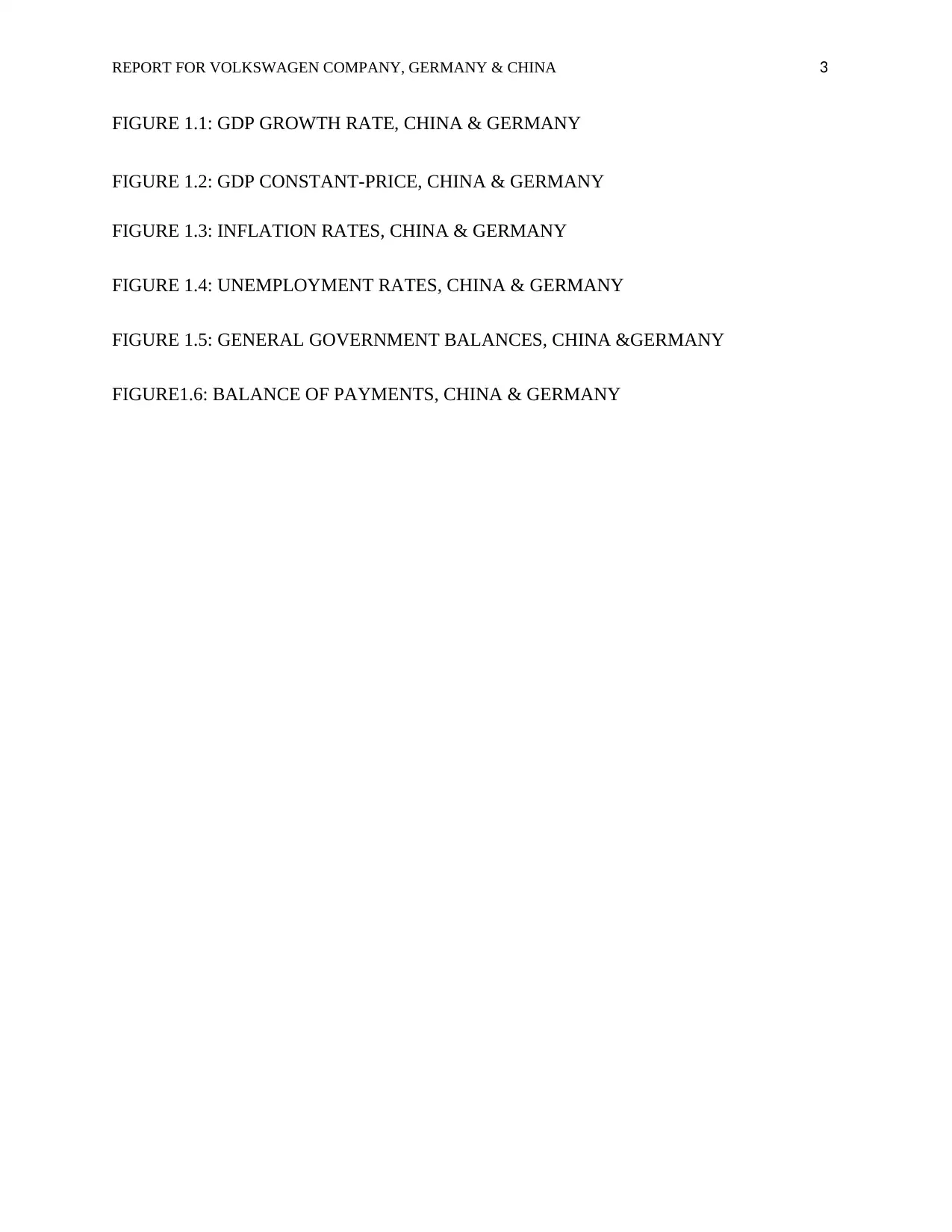
REPORT FOR VOLKSWAGEN COMPANY, GERMANY & CHINA 3
FIGURE 1.1: GDP GROWTH RATE, CHINA & GERMANY
FIGURE 1.2: GDP CONSTANT-PRICE, CHINA & GERMANY
FIGURE 1.3: INFLATION RATES, CHINA & GERMANY
FIGURE 1.4: UNEMPLOYMENT RATES, CHINA & GERMANY
FIGURE 1.5: GENERAL GOVERNMENT BALANCES, CHINA &GERMANY
FIGURE1.6: BALANCE OF PAYMENTS, CHINA & GERMANY
FIGURE 1.1: GDP GROWTH RATE, CHINA & GERMANY
FIGURE 1.2: GDP CONSTANT-PRICE, CHINA & GERMANY
FIGURE 1.3: INFLATION RATES, CHINA & GERMANY
FIGURE 1.4: UNEMPLOYMENT RATES, CHINA & GERMANY
FIGURE 1.5: GENERAL GOVERNMENT BALANCES, CHINA &GERMANY
FIGURE1.6: BALANCE OF PAYMENTS, CHINA & GERMANY
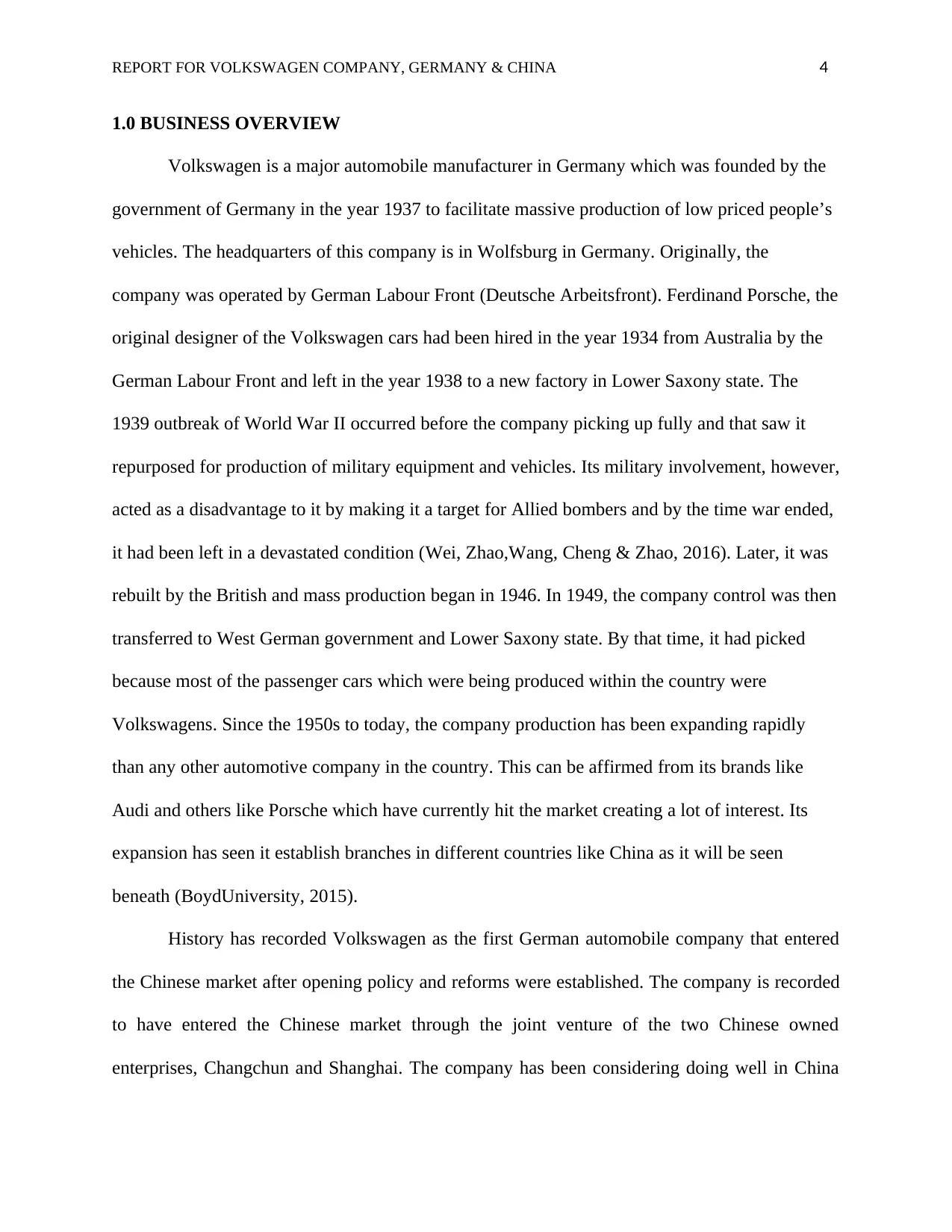
REPORT FOR VOLKSWAGEN COMPANY, GERMANY & CHINA 4
1.0 BUSINESS OVERVIEW
Volkswagen is a major automobile manufacturer in Germany which was founded by the
government of Germany in the year 1937 to facilitate massive production of low priced people’s
vehicles. The headquarters of this company is in Wolfsburg in Germany. Originally, the
company was operated by German Labour Front (Deutsche Arbeitsfront). Ferdinand Porsche, the
original designer of the Volkswagen cars had been hired in the year 1934 from Australia by the
German Labour Front and left in the year 1938 to a new factory in Lower Saxony state. The
1939 outbreak of World War II occurred before the company picking up fully and that saw it
repurposed for production of military equipment and vehicles. Its military involvement, however,
acted as a disadvantage to it by making it a target for Allied bombers and by the time war ended,
it had been left in a devastated condition (Wei, Zhao,Wang, Cheng & Zhao, 2016). Later, it was
rebuilt by the British and mass production began in 1946. In 1949, the company control was then
transferred to West German government and Lower Saxony state. By that time, it had picked
because most of the passenger cars which were being produced within the country were
Volkswagens. Since the 1950s to today, the company production has been expanding rapidly
than any other automotive company in the country. This can be affirmed from its brands like
Audi and others like Porsche which have currently hit the market creating a lot of interest. Its
expansion has seen it establish branches in different countries like China as it will be seen
beneath (BoydUniversity, 2015).
History has recorded Volkswagen as the first German automobile company that entered
the Chinese market after opening policy and reforms were established. The company is recorded
to have entered the Chinese market through the joint venture of the two Chinese owned
enterprises, Changchun and Shanghai. The company has been considering doing well in China
1.0 BUSINESS OVERVIEW
Volkswagen is a major automobile manufacturer in Germany which was founded by the
government of Germany in the year 1937 to facilitate massive production of low priced people’s
vehicles. The headquarters of this company is in Wolfsburg in Germany. Originally, the
company was operated by German Labour Front (Deutsche Arbeitsfront). Ferdinand Porsche, the
original designer of the Volkswagen cars had been hired in the year 1934 from Australia by the
German Labour Front and left in the year 1938 to a new factory in Lower Saxony state. The
1939 outbreak of World War II occurred before the company picking up fully and that saw it
repurposed for production of military equipment and vehicles. Its military involvement, however,
acted as a disadvantage to it by making it a target for Allied bombers and by the time war ended,
it had been left in a devastated condition (Wei, Zhao,Wang, Cheng & Zhao, 2016). Later, it was
rebuilt by the British and mass production began in 1946. In 1949, the company control was then
transferred to West German government and Lower Saxony state. By that time, it had picked
because most of the passenger cars which were being produced within the country were
Volkswagens. Since the 1950s to today, the company production has been expanding rapidly
than any other automotive company in the country. This can be affirmed from its brands like
Audi and others like Porsche which have currently hit the market creating a lot of interest. Its
expansion has seen it establish branches in different countries like China as it will be seen
beneath (BoydUniversity, 2015).
History has recorded Volkswagen as the first German automobile company that entered
the Chinese market after opening policy and reforms were established. The company is recorded
to have entered the Chinese market through the joint venture of the two Chinese owned
enterprises, Changchun and Shanghai. The company has been considering doing well in China
Secure Best Marks with AI Grader
Need help grading? Try our AI Grader for instant feedback on your assignments.
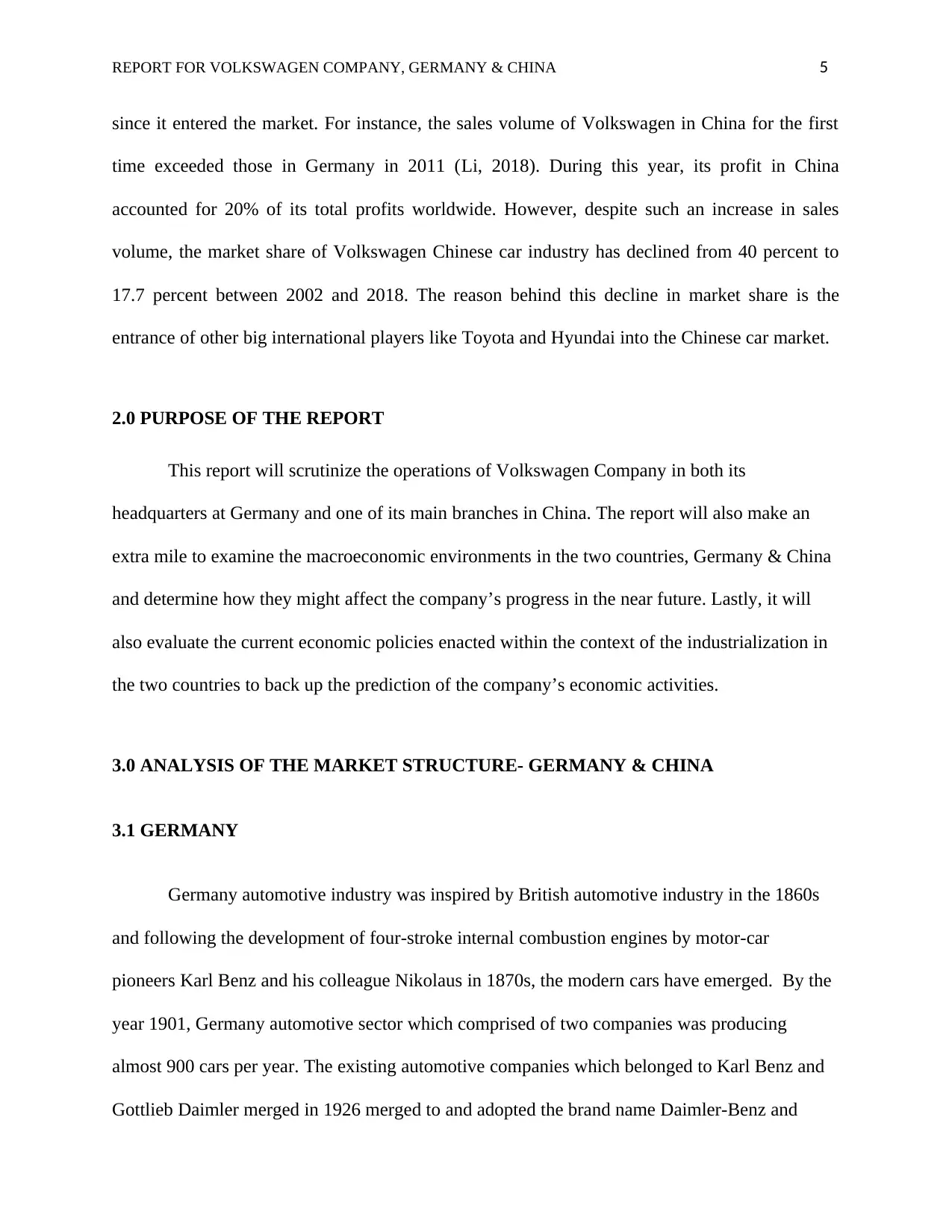
REPORT FOR VOLKSWAGEN COMPANY, GERMANY & CHINA 5
since it entered the market. For instance, the sales volume of Volkswagen in China for the first
time exceeded those in Germany in 2011 (Li, 2018). During this year, its profit in China
accounted for 20% of its total profits worldwide. However, despite such an increase in sales
volume, the market share of Volkswagen Chinese car industry has declined from 40 percent to
17.7 percent between 2002 and 2018. The reason behind this decline in market share is the
entrance of other big international players like Toyota and Hyundai into the Chinese car market.
2.0 PURPOSE OF THE REPORT
This report will scrutinize the operations of Volkswagen Company in both its
headquarters at Germany and one of its main branches in China. The report will also make an
extra mile to examine the macroeconomic environments in the two countries, Germany & China
and determine how they might affect the company’s progress in the near future. Lastly, it will
also evaluate the current economic policies enacted within the context of the industrialization in
the two countries to back up the prediction of the company’s economic activities.
3.0 ANALYSIS OF THE MARKET STRUCTURE- GERMANY & CHINA
3.1 GERMANY
Germany automotive industry was inspired by British automotive industry in the 1860s
and following the development of four-stroke internal combustion engines by motor-car
pioneers Karl Benz and his colleague Nikolaus in 1870s, the modern cars have emerged. By the
year 1901, Germany automotive sector which comprised of two companies was producing
almost 900 cars per year. The existing automotive companies which belonged to Karl Benz and
Gottlieb Daimler merged in 1926 merged to and adopted the brand name Daimler-Benz and
since it entered the market. For instance, the sales volume of Volkswagen in China for the first
time exceeded those in Germany in 2011 (Li, 2018). During this year, its profit in China
accounted for 20% of its total profits worldwide. However, despite such an increase in sales
volume, the market share of Volkswagen Chinese car industry has declined from 40 percent to
17.7 percent between 2002 and 2018. The reason behind this decline in market share is the
entrance of other big international players like Toyota and Hyundai into the Chinese car market.
2.0 PURPOSE OF THE REPORT
This report will scrutinize the operations of Volkswagen Company in both its
headquarters at Germany and one of its main branches in China. The report will also make an
extra mile to examine the macroeconomic environments in the two countries, Germany & China
and determine how they might affect the company’s progress in the near future. Lastly, it will
also evaluate the current economic policies enacted within the context of the industrialization in
the two countries to back up the prediction of the company’s economic activities.
3.0 ANALYSIS OF THE MARKET STRUCTURE- GERMANY & CHINA
3.1 GERMANY
Germany automotive industry was inspired by British automotive industry in the 1860s
and following the development of four-stroke internal combustion engines by motor-car
pioneers Karl Benz and his colleague Nikolaus in 1870s, the modern cars have emerged. By the
year 1901, Germany automotive sector which comprised of two companies was producing
almost 900 cars per year. The existing automotive companies which belonged to Karl Benz and
Gottlieb Daimler merged in 1926 merged to and adopted the brand name Daimler-Benz and
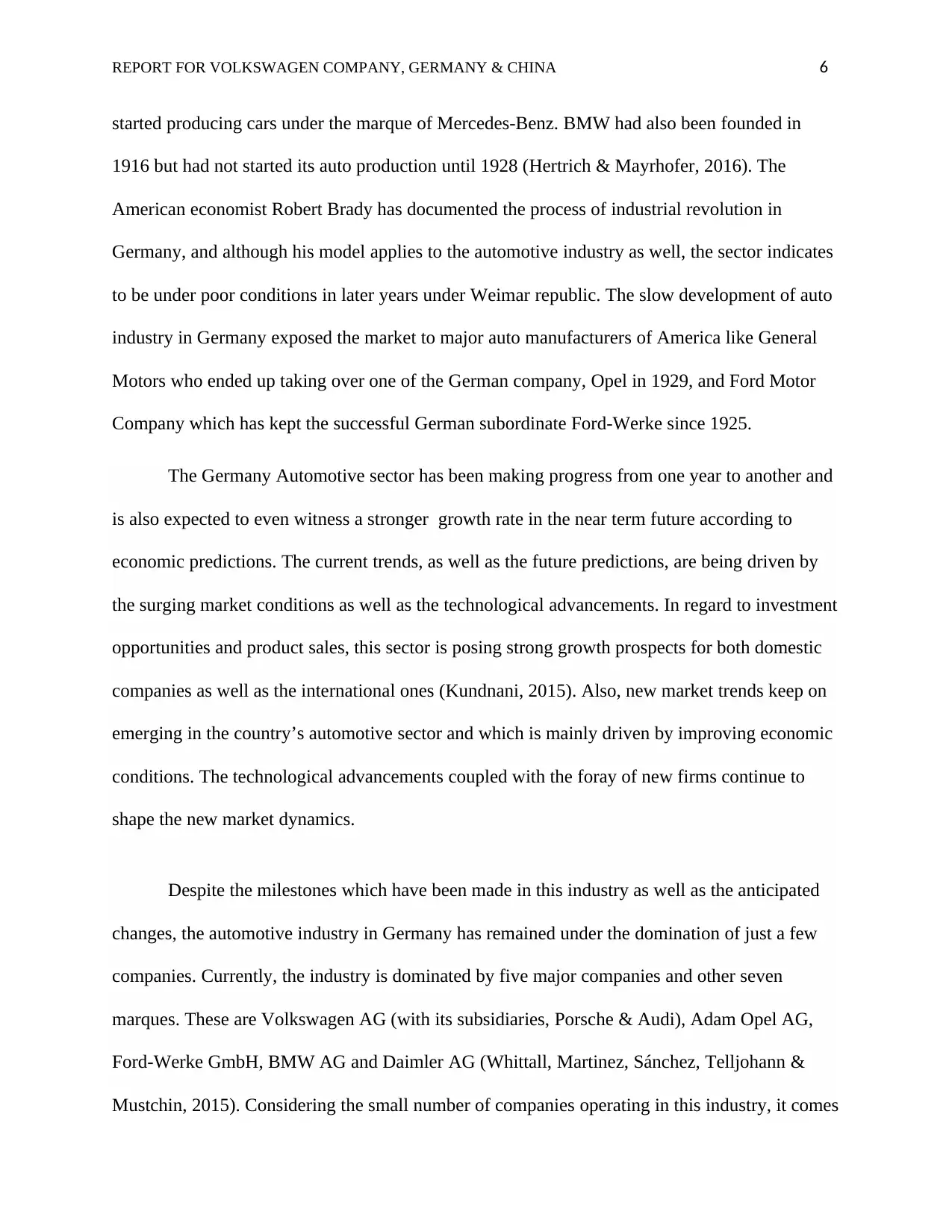
REPORT FOR VOLKSWAGEN COMPANY, GERMANY & CHINA 6
started producing cars under the marque of Mercedes-Benz. BMW had also been founded in
1916 but had not started its auto production until 1928 (Hertrich & Mayrhofer, 2016). The
American economist Robert Brady has documented the process of industrial revolution in
Germany, and although his model applies to the automotive industry as well, the sector indicates
to be under poor conditions in later years under Weimar republic. The slow development of auto
industry in Germany exposed the market to major auto manufacturers of America like General
Motors who ended up taking over one of the German company, Opel in 1929, and Ford Motor
Company which has kept the successful German subordinate Ford-Werke since 1925.
The Germany Automotive sector has been making progress from one year to another and
is also expected to even witness a stronger growth rate in the near term future according to
economic predictions. The current trends, as well as the future predictions, are being driven by
the surging market conditions as well as the technological advancements. In regard to investment
opportunities and product sales, this sector is posing strong growth prospects for both domestic
companies as well as the international ones (Kundnani, 2015). Also, new market trends keep on
emerging in the country’s automotive sector and which is mainly driven by improving economic
conditions. The technological advancements coupled with the foray of new firms continue to
shape the new market dynamics.
Despite the milestones which have been made in this industry as well as the anticipated
changes, the automotive industry in Germany has remained under the domination of just a few
companies. Currently, the industry is dominated by five major companies and other seven
marques. These are Volkswagen AG (with its subsidiaries, Porsche & Audi), Adam Opel AG,
Ford-Werke GmbH, BMW AG and Daimler AG (Whittall, Martinez, Sánchez, Telljohann &
Mustchin, 2015). Considering the small number of companies operating in this industry, it comes
started producing cars under the marque of Mercedes-Benz. BMW had also been founded in
1916 but had not started its auto production until 1928 (Hertrich & Mayrhofer, 2016). The
American economist Robert Brady has documented the process of industrial revolution in
Germany, and although his model applies to the automotive industry as well, the sector indicates
to be under poor conditions in later years under Weimar republic. The slow development of auto
industry in Germany exposed the market to major auto manufacturers of America like General
Motors who ended up taking over one of the German company, Opel in 1929, and Ford Motor
Company which has kept the successful German subordinate Ford-Werke since 1925.
The Germany Automotive sector has been making progress from one year to another and
is also expected to even witness a stronger growth rate in the near term future according to
economic predictions. The current trends, as well as the future predictions, are being driven by
the surging market conditions as well as the technological advancements. In regard to investment
opportunities and product sales, this sector is posing strong growth prospects for both domestic
companies as well as the international ones (Kundnani, 2015). Also, new market trends keep on
emerging in the country’s automotive sector and which is mainly driven by improving economic
conditions. The technological advancements coupled with the foray of new firms continue to
shape the new market dynamics.
Despite the milestones which have been made in this industry as well as the anticipated
changes, the automotive industry in Germany has remained under the domination of just a few
companies. Currently, the industry is dominated by five major companies and other seven
marques. These are Volkswagen AG (with its subsidiaries, Porsche & Audi), Adam Opel AG,
Ford-Werke GmbH, BMW AG and Daimler AG (Whittall, Martinez, Sánchez, Telljohann &
Mustchin, 2015). Considering the small number of companies operating in this industry, it comes

REPORT FOR VOLKSWAGEN COMPANY, GERMANY & CHINA 7
out without any reasonable doubt that this sector is under the Oligopoly type of market structure.
This is in consideration of the characteristics of this market structure: a large number of potential
buyers and few sellers, differentiated products and the presence of barriers to entry. A further
breakdown of this industry lands it to an impure oligopoly because the firms lack competition
and use product differentiation as the main source of market power (Goodwin, Harris, Nelson,
Roach & Torras, 2015).
3.2 CHINA
The history of China automobile industry has been traced back from the Soviet people;
the licensed auto designs which were founded in the 1950s by the USSR and which had small
volumes of between 100 and 200 thousand per year. The start of 1990 has seen this sector
develop very to exceed the production capacity of one million by the year 1992. By 2000, the
country was producing over two million vehicles per year. After its entry into the World Trade
Organization in 2001, the automobile sector of China’s economy has continued to accelerate
further (Feuerriegel & Gordon, 2018). Between the year 2002 and 2007, the sector grew by 21%,
or one million vehicles a year after the other. In 2009, the country produced 13.79 million
vehicles, of which 3.41 million were commercial vehicles and 8 million passenger cars, taking
the position which had been occupied States as the largest vehicle producer globally. In the
preceding year, both production and sells topped 18 million vehicles; 13.76 million being
passenger vehicles. In 2014, the total production hit a mark of 23.720 million, which was
approximately 26% of the world’s automotive production
The automobile industry in China has since then maintained its position as a ringleader,
exceeding the European Union or that of both Japan and US combined. Despite these interesting
out without any reasonable doubt that this sector is under the Oligopoly type of market structure.
This is in consideration of the characteristics of this market structure: a large number of potential
buyers and few sellers, differentiated products and the presence of barriers to entry. A further
breakdown of this industry lands it to an impure oligopoly because the firms lack competition
and use product differentiation as the main source of market power (Goodwin, Harris, Nelson,
Roach & Torras, 2015).
3.2 CHINA
The history of China automobile industry has been traced back from the Soviet people;
the licensed auto designs which were founded in the 1950s by the USSR and which had small
volumes of between 100 and 200 thousand per year. The start of 1990 has seen this sector
develop very to exceed the production capacity of one million by the year 1992. By 2000, the
country was producing over two million vehicles per year. After its entry into the World Trade
Organization in 2001, the automobile sector of China’s economy has continued to accelerate
further (Feuerriegel & Gordon, 2018). Between the year 2002 and 2007, the sector grew by 21%,
or one million vehicles a year after the other. In 2009, the country produced 13.79 million
vehicles, of which 3.41 million were commercial vehicles and 8 million passenger cars, taking
the position which had been occupied States as the largest vehicle producer globally. In the
preceding year, both production and sells topped 18 million vehicles; 13.76 million being
passenger vehicles. In 2014, the total production hit a mark of 23.720 million, which was
approximately 26% of the world’s automotive production
The automobile industry in China has since then maintained its position as a ringleader,
exceeding the European Union or that of both Japan and US combined. Despite these interesting
Paraphrase This Document
Need a fresh take? Get an instant paraphrase of this document with our AI Paraphraser
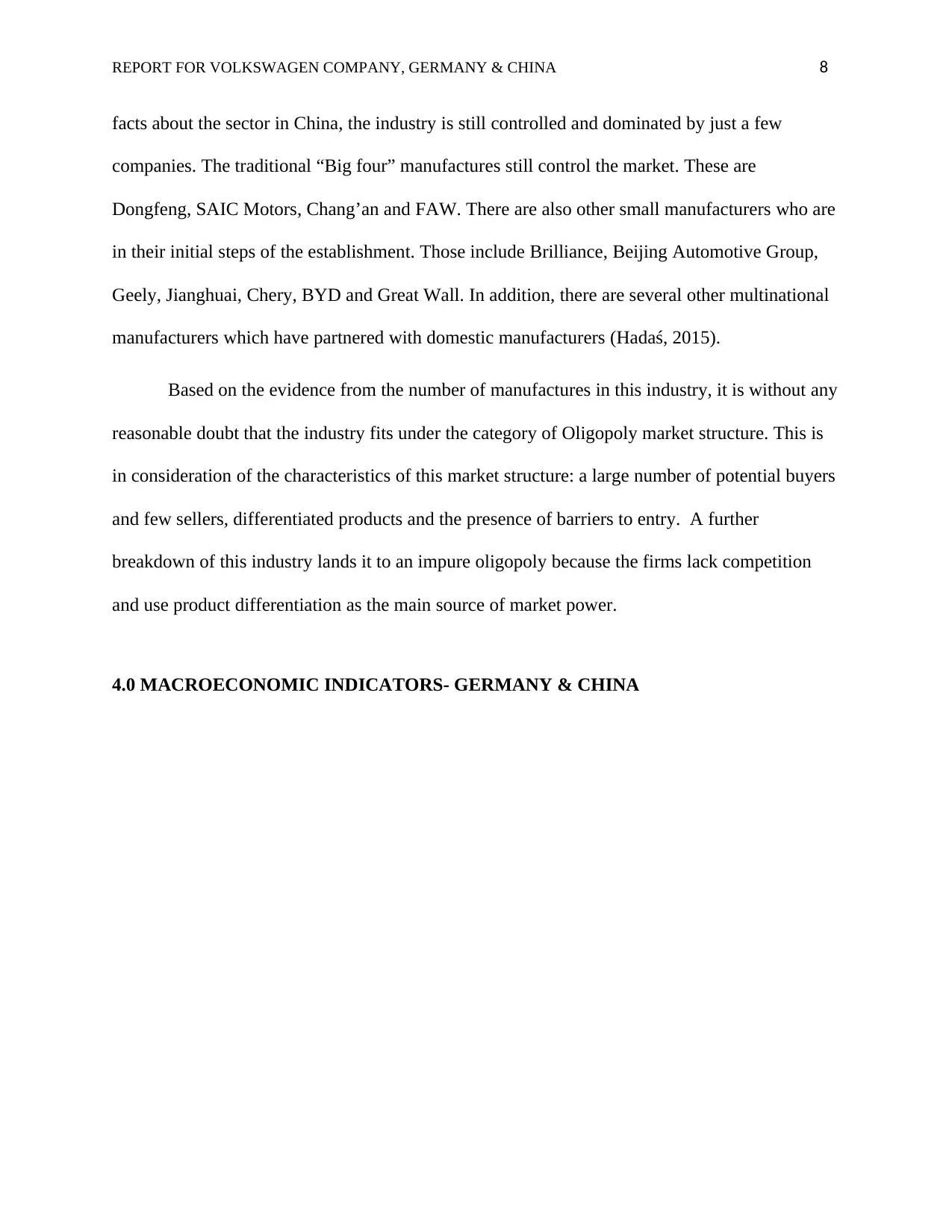
REPORT FOR VOLKSWAGEN COMPANY, GERMANY & CHINA 8
facts about the sector in China, the industry is still controlled and dominated by just a few
companies. The traditional “Big four” manufactures still control the market. These are
Dongfeng, SAIC Motors, Chang’an and FAW. There are also other small manufacturers who are
in their initial steps of the establishment. Those include Brilliance, Beijing Automotive Group,
Geely, Jianghuai, Chery, BYD and Great Wall. In addition, there are several other multinational
manufacturers which have partnered with domestic manufacturers (Hadaś, 2015).
Based on the evidence from the number of manufactures in this industry, it is without any
reasonable doubt that the industry fits under the category of Oligopoly market structure. This is
in consideration of the characteristics of this market structure: a large number of potential buyers
and few sellers, differentiated products and the presence of barriers to entry. A further
breakdown of this industry lands it to an impure oligopoly because the firms lack competition
and use product differentiation as the main source of market power.
4.0 MACROECONOMIC INDICATORS- GERMANY & CHINA
facts about the sector in China, the industry is still controlled and dominated by just a few
companies. The traditional “Big four” manufactures still control the market. These are
Dongfeng, SAIC Motors, Chang’an and FAW. There are also other small manufacturers who are
in their initial steps of the establishment. Those include Brilliance, Beijing Automotive Group,
Geely, Jianghuai, Chery, BYD and Great Wall. In addition, there are several other multinational
manufacturers which have partnered with domestic manufacturers (Hadaś, 2015).
Based on the evidence from the number of manufactures in this industry, it is without any
reasonable doubt that the industry fits under the category of Oligopoly market structure. This is
in consideration of the characteristics of this market structure: a large number of potential buyers
and few sellers, differentiated products and the presence of barriers to entry. A further
breakdown of this industry lands it to an impure oligopoly because the firms lack competition
and use product differentiation as the main source of market power.
4.0 MACROECONOMIC INDICATORS- GERMANY & CHINA
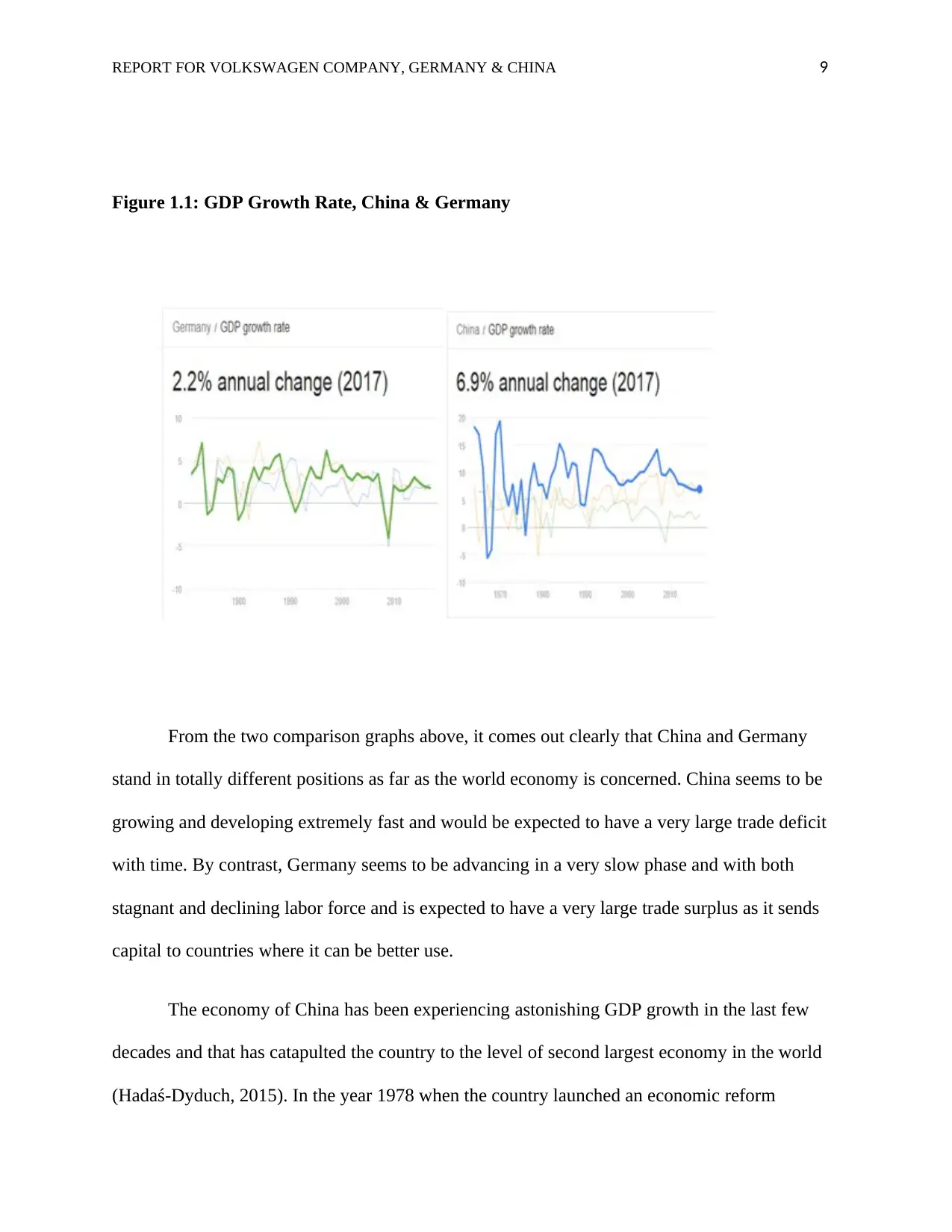
REPORT FOR VOLKSWAGEN COMPANY, GERMANY & CHINA 9
Figure 1.1: GDP Growth Rate, China & Germany
From the two comparison graphs above, it comes out clearly that China and Germany
stand in totally different positions as far as the world economy is concerned. China seems to be
growing and developing extremely fast and would be expected to have a very large trade deficit
with time. By contrast, Germany seems to be advancing in a very slow phase and with both
stagnant and declining labor force and is expected to have a very large trade surplus as it sends
capital to countries where it can be better use.
The economy of China has been experiencing astonishing GDP growth in the last few
decades and that has catapulted the country to the level of second largest economy in the world
(Hadaś-Dyduch, 2015). In the year 1978 when the country launched an economic reform
Figure 1.1: GDP Growth Rate, China & Germany
From the two comparison graphs above, it comes out clearly that China and Germany
stand in totally different positions as far as the world economy is concerned. China seems to be
growing and developing extremely fast and would be expected to have a very large trade deficit
with time. By contrast, Germany seems to be advancing in a very slow phase and with both
stagnant and declining labor force and is expected to have a very large trade surplus as it sends
capital to countries where it can be better use.
The economy of China has been experiencing astonishing GDP growth in the last few
decades and that has catapulted the country to the level of second largest economy in the world
(Hadaś-Dyduch, 2015). In the year 1978 when the country launched an economic reform
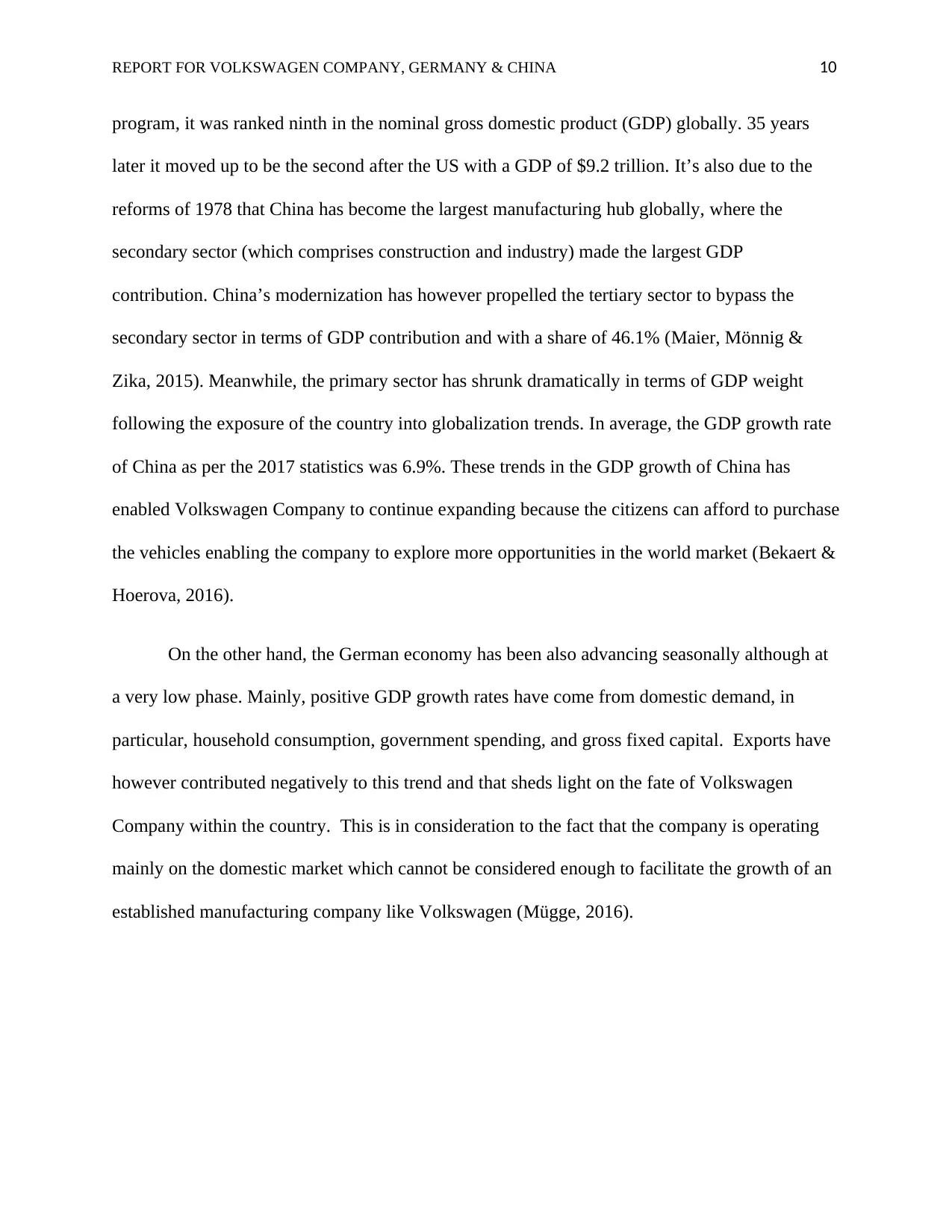
REPORT FOR VOLKSWAGEN COMPANY, GERMANY & CHINA 10
program, it was ranked ninth in the nominal gross domestic product (GDP) globally. 35 years
later it moved up to be the second after the US with a GDP of $9.2 trillion. It’s also due to the
reforms of 1978 that China has become the largest manufacturing hub globally, where the
secondary sector (which comprises construction and industry) made the largest GDP
contribution. China’s modernization has however propelled the tertiary sector to bypass the
secondary sector in terms of GDP contribution and with a share of 46.1% (Maier, Mönnig &
Zika, 2015). Meanwhile, the primary sector has shrunk dramatically in terms of GDP weight
following the exposure of the country into globalization trends. In average, the GDP growth rate
of China as per the 2017 statistics was 6.9%. These trends in the GDP growth of China has
enabled Volkswagen Company to continue expanding because the citizens can afford to purchase
the vehicles enabling the company to explore more opportunities in the world market (Bekaert &
Hoerova, 2016).
On the other hand, the German economy has been also advancing seasonally although at
a very low phase. Mainly, positive GDP growth rates have come from domestic demand, in
particular, household consumption, government spending, and gross fixed capital. Exports have
however contributed negatively to this trend and that sheds light on the fate of Volkswagen
Company within the country. This is in consideration to the fact that the company is operating
mainly on the domestic market which cannot be considered enough to facilitate the growth of an
established manufacturing company like Volkswagen (Mügge, 2016).
program, it was ranked ninth in the nominal gross domestic product (GDP) globally. 35 years
later it moved up to be the second after the US with a GDP of $9.2 trillion. It’s also due to the
reforms of 1978 that China has become the largest manufacturing hub globally, where the
secondary sector (which comprises construction and industry) made the largest GDP
contribution. China’s modernization has however propelled the tertiary sector to bypass the
secondary sector in terms of GDP contribution and with a share of 46.1% (Maier, Mönnig &
Zika, 2015). Meanwhile, the primary sector has shrunk dramatically in terms of GDP weight
following the exposure of the country into globalization trends. In average, the GDP growth rate
of China as per the 2017 statistics was 6.9%. These trends in the GDP growth of China has
enabled Volkswagen Company to continue expanding because the citizens can afford to purchase
the vehicles enabling the company to explore more opportunities in the world market (Bekaert &
Hoerova, 2016).
On the other hand, the German economy has been also advancing seasonally although at
a very low phase. Mainly, positive GDP growth rates have come from domestic demand, in
particular, household consumption, government spending, and gross fixed capital. Exports have
however contributed negatively to this trend and that sheds light on the fate of Volkswagen
Company within the country. This is in consideration to the fact that the company is operating
mainly on the domestic market which cannot be considered enough to facilitate the growth of an
established manufacturing company like Volkswagen (Mügge, 2016).
Secure Best Marks with AI Grader
Need help grading? Try our AI Grader for instant feedback on your assignments.
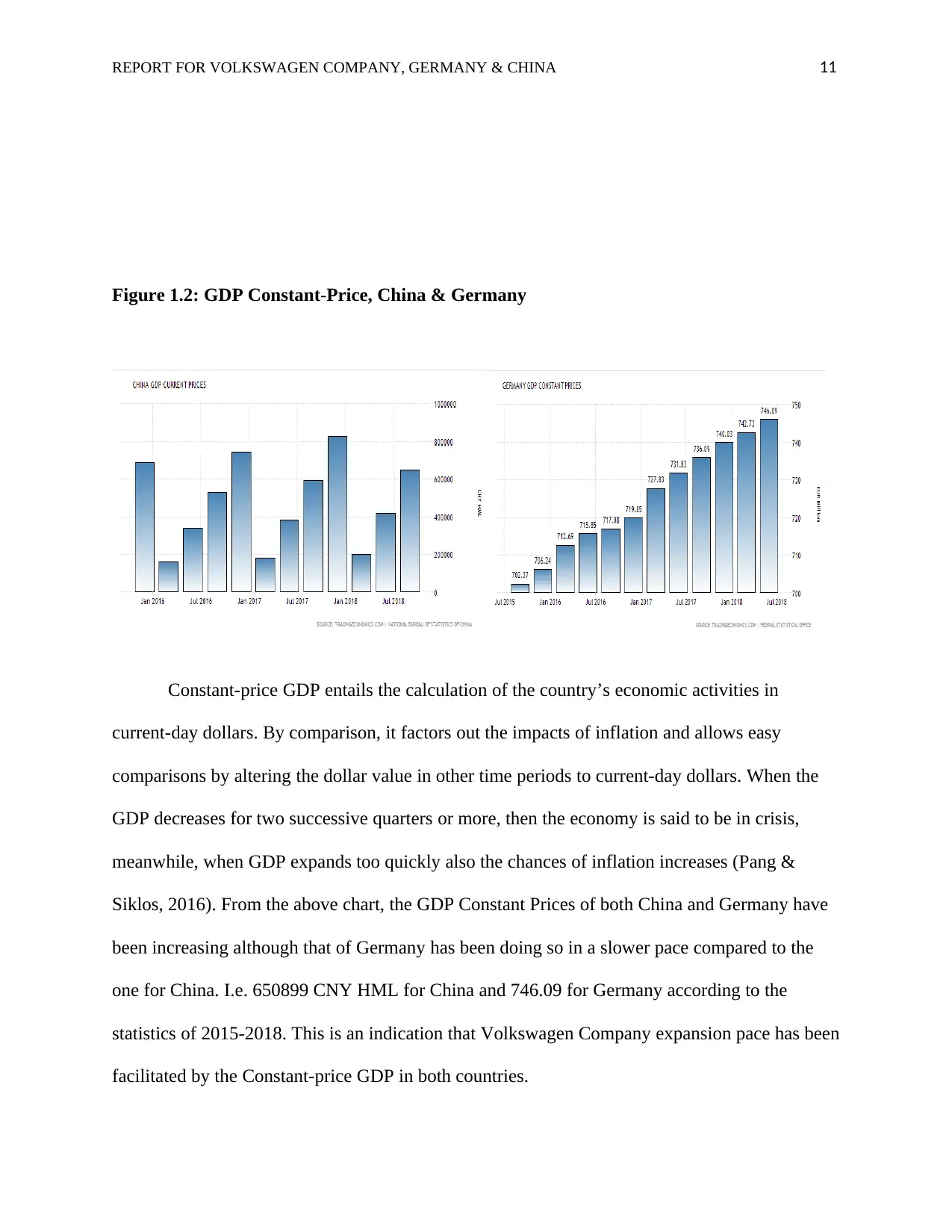
REPORT FOR VOLKSWAGEN COMPANY, GERMANY & CHINA 11
Figure 1.2: GDP Constant-Price, China & Germany
Constant-price GDP entails the calculation of the country’s economic activities in
current-day dollars. By comparison, it factors out the impacts of inflation and allows easy
comparisons by altering the dollar value in other time periods to current-day dollars. When the
GDP decreases for two successive quarters or more, then the economy is said to be in crisis,
meanwhile, when GDP expands too quickly also the chances of inflation increases (Pang &
Siklos, 2016). From the above chart, the GDP Constant Prices of both China and Germany have
been increasing although that of Germany has been doing so in a slower pace compared to the
one for China. I.e. 650899 CNY HML for China and 746.09 for Germany according to the
statistics of 2015-2018. This is an indication that Volkswagen Company expansion pace has been
facilitated by the Constant-price GDP in both countries.
Figure 1.2: GDP Constant-Price, China & Germany
Constant-price GDP entails the calculation of the country’s economic activities in
current-day dollars. By comparison, it factors out the impacts of inflation and allows easy
comparisons by altering the dollar value in other time periods to current-day dollars. When the
GDP decreases for two successive quarters or more, then the economy is said to be in crisis,
meanwhile, when GDP expands too quickly also the chances of inflation increases (Pang &
Siklos, 2016). From the above chart, the GDP Constant Prices of both China and Germany have
been increasing although that of Germany has been doing so in a slower pace compared to the
one for China. I.e. 650899 CNY HML for China and 746.09 for Germany according to the
statistics of 2015-2018. This is an indication that Volkswagen Company expansion pace has been
facilitated by the Constant-price GDP in both countries.
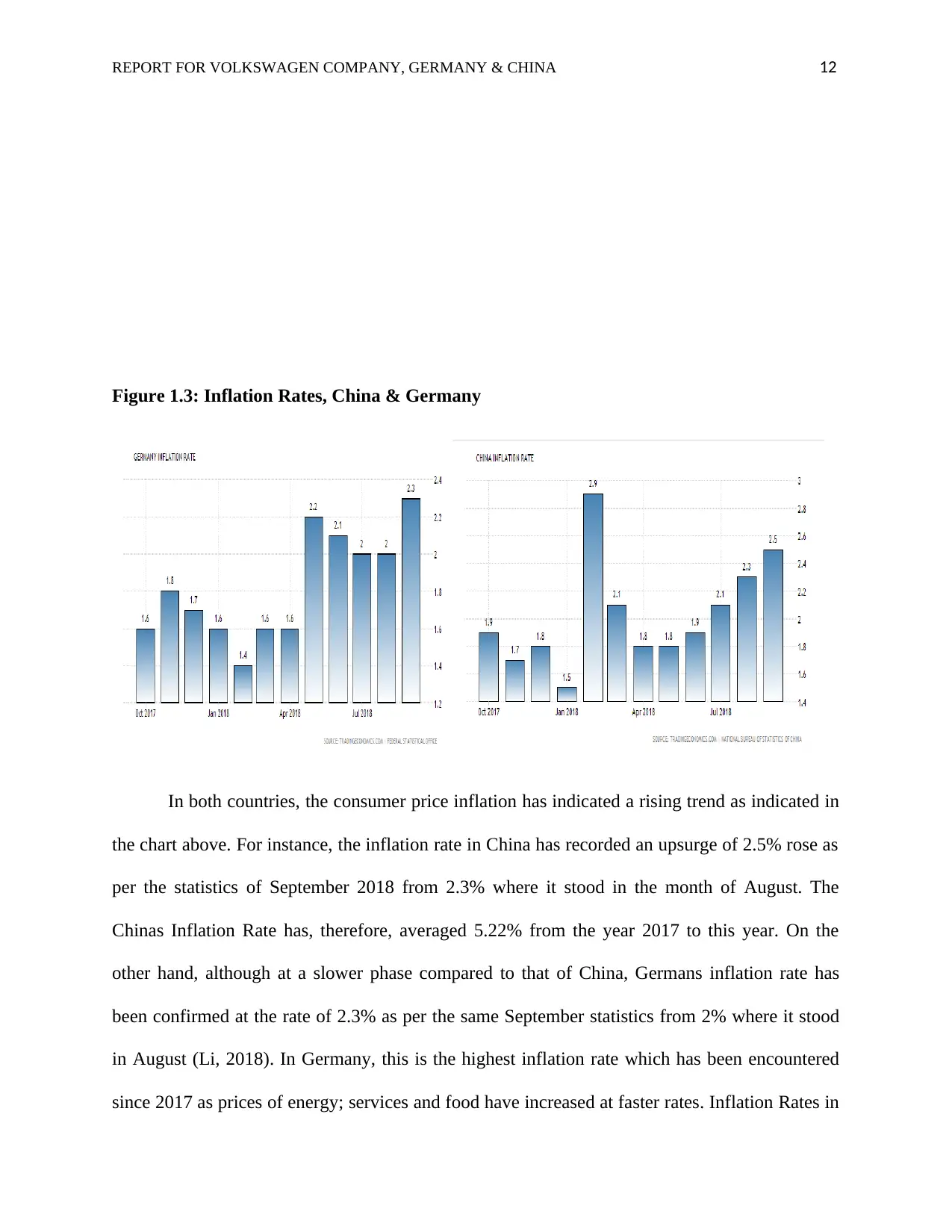
REPORT FOR VOLKSWAGEN COMPANY, GERMANY & CHINA 12
Figure 1.3: Inflation Rates, China & Germany
In both countries, the consumer price inflation has indicated a rising trend as indicated in
the chart above. For instance, the inflation rate in China has recorded an upsurge of 2.5% rose as
per the statistics of September 2018 from 2.3% where it stood in the month of August. The
Chinas Inflation Rate has, therefore, averaged 5.22% from the year 2017 to this year. On the
other hand, although at a slower phase compared to that of China, Germans inflation rate has
been confirmed at the rate of 2.3% as per the same September statistics from 2% where it stood
in August (Li, 2018). In Germany, this is the highest inflation rate which has been encountered
since 2017 as prices of energy; services and food have increased at faster rates. Inflation Rates in
Figure 1.3: Inflation Rates, China & Germany
In both countries, the consumer price inflation has indicated a rising trend as indicated in
the chart above. For instance, the inflation rate in China has recorded an upsurge of 2.5% rose as
per the statistics of September 2018 from 2.3% where it stood in the month of August. The
Chinas Inflation Rate has, therefore, averaged 5.22% from the year 2017 to this year. On the
other hand, although at a slower phase compared to that of China, Germans inflation rate has
been confirmed at the rate of 2.3% as per the same September statistics from 2% where it stood
in August (Li, 2018). In Germany, this is the highest inflation rate which has been encountered
since 2017 as prices of energy; services and food have increased at faster rates. Inflation Rates in

REPORT FOR VOLKSWAGEN COMPANY, GERMANY & CHINA 13
Germany have averaged 2.39% from 2017 to 2018. Increasing Inflation rates are known to lower
the real incomes and that has directly affected the purchases of Volkswagen Company since the
company deals with products which are not basic.
Figure 1.4: Unemployment Rates, China & Germany
From the chart above, it is clearly evident that the unemployment rates for both countries
as per the current statistics of September are low. For instance, we get to know that the
unemployment rates in Germany have stood at 3.4% in 2018, which is a rate unchanged from the
previous few months and which is the lowest mark for the last 38 years. The country’s
unemployment rate has averaged at the mark of 5.58% from 2015 up to today. On the other hand,
the rate of Unemployment in China has recorded a decline from 3.89% to 3.83% between
January and September, averaging 4.10% between 2015 and 2018. Comparing the statistics of
unemployment rates in these two countries with others, it comes out clearly that the
Germany have averaged 2.39% from 2017 to 2018. Increasing Inflation rates are known to lower
the real incomes and that has directly affected the purchases of Volkswagen Company since the
company deals with products which are not basic.
Figure 1.4: Unemployment Rates, China & Germany
From the chart above, it is clearly evident that the unemployment rates for both countries
as per the current statistics of September are low. For instance, we get to know that the
unemployment rates in Germany have stood at 3.4% in 2018, which is a rate unchanged from the
previous few months and which is the lowest mark for the last 38 years. The country’s
unemployment rate has averaged at the mark of 5.58% from 2015 up to today. On the other hand,
the rate of Unemployment in China has recorded a decline from 3.89% to 3.83% between
January and September, averaging 4.10% between 2015 and 2018. Comparing the statistics of
unemployment rates in these two countries with others, it comes out clearly that the
Paraphrase This Document
Need a fresh take? Get an instant paraphrase of this document with our AI Paraphraser

REPORT FOR VOLKSWAGEN COMPANY, GERMANY & CHINA 14
unemployment rates in the two countries are low (Mügge, 2015). Low unemployment rates mean
low dependency levels and that in turn means that citizens are able to satisfy their secondary
needs like purchasing of vehicles and other luxuries. This can be attributed to the considerable
expansion of the Volkswagen Company in the two countries.
Figure 1.5: General government balances, China &Germany
In regard to the balance of payments, both China and Germany have recorded positive
progress as evident in the chart above. For instance, China has recorded a Government Budget
deficit of 3.50% of its total Gross Domestic Product as per the current statistics. The Government
Budget of the country has therefore averaged at -2.08% of GDP between 2015 and 2018. On the
other hand, Germany has recorded a budget surplus of 10.72 EUR Billion as per the recent
statistics of 2018. Its Budget Value has therefore averaged -11.85 EUR Billion between 2015 and
2018. From these statistics regarding the balance of payments, it comes out clearly that the two
governments have the ability to support their economic growth (Hadaś, 2015). That means the
unemployment rates in the two countries are low (Mügge, 2015). Low unemployment rates mean
low dependency levels and that in turn means that citizens are able to satisfy their secondary
needs like purchasing of vehicles and other luxuries. This can be attributed to the considerable
expansion of the Volkswagen Company in the two countries.
Figure 1.5: General government balances, China &Germany
In regard to the balance of payments, both China and Germany have recorded positive
progress as evident in the chart above. For instance, China has recorded a Government Budget
deficit of 3.50% of its total Gross Domestic Product as per the current statistics. The Government
Budget of the country has therefore averaged at -2.08% of GDP between 2015 and 2018. On the
other hand, Germany has recorded a budget surplus of 10.72 EUR Billion as per the recent
statistics of 2018. Its Budget Value has therefore averaged -11.85 EUR Billion between 2015 and
2018. From these statistics regarding the balance of payments, it comes out clearly that the two
governments have the ability to support their economic growth (Hadaś, 2015). That means the
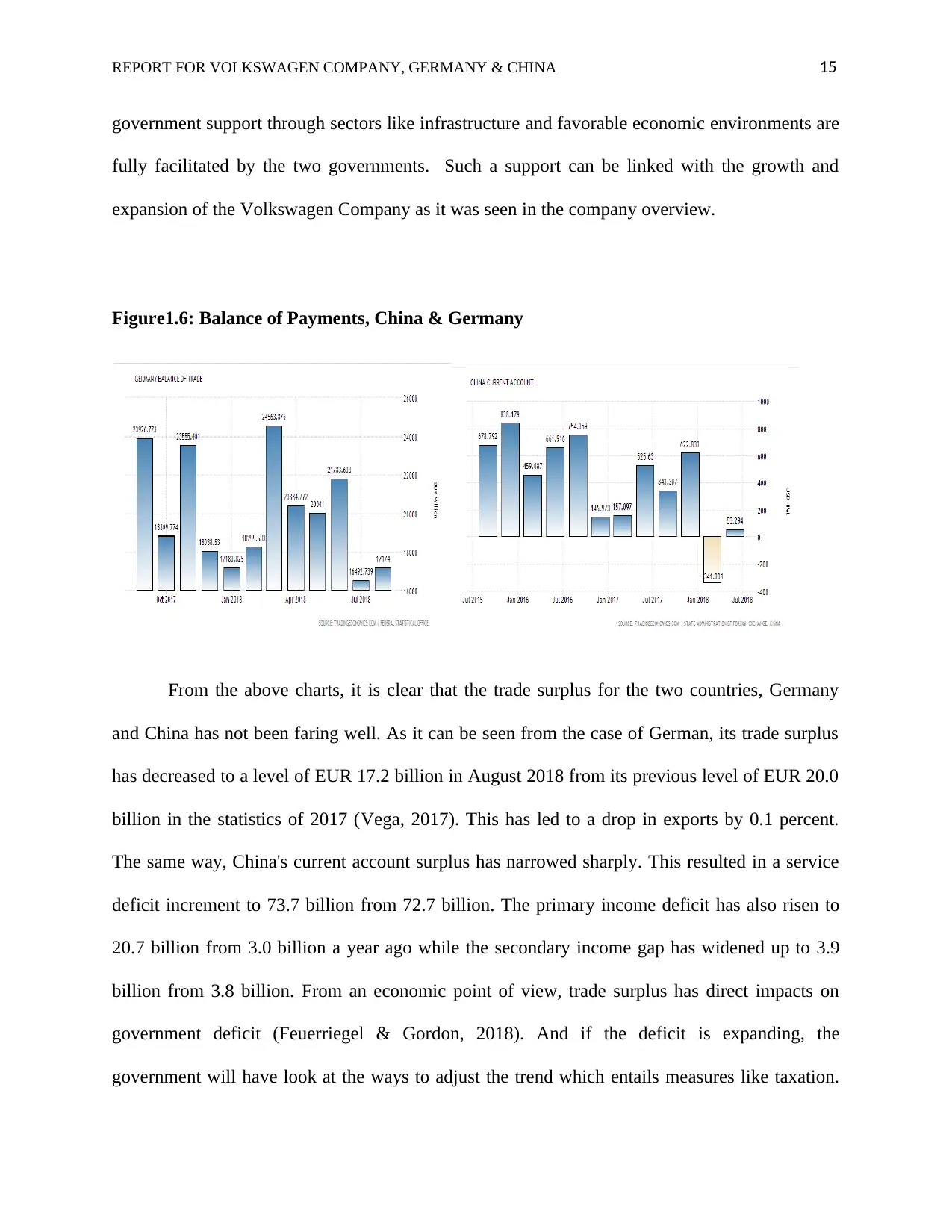
REPORT FOR VOLKSWAGEN COMPANY, GERMANY & CHINA 15
government support through sectors like infrastructure and favorable economic environments are
fully facilitated by the two governments. Such a support can be linked with the growth and
expansion of the Volkswagen Company as it was seen in the company overview.
Figure1.6: Balance of Payments, China & Germany
From the above charts, it is clear that the trade surplus for the two countries, Germany
and China has not been faring well. As it can be seen from the case of German, its trade surplus
has decreased to a level of EUR 17.2 billion in August 2018 from its previous level of EUR 20.0
billion in the statistics of 2017 (Vega, 2017). This has led to a drop in exports by 0.1 percent.
The same way, China's current account surplus has narrowed sharply. This resulted in a service
deficit increment to 73.7 billion from 72.7 billion. The primary income deficit has also risen to
20.7 billion from 3.0 billion a year ago while the secondary income gap has widened up to 3.9
billion from 3.8 billion. From an economic point of view, trade surplus has direct impacts on
government deficit (Feuerriegel & Gordon, 2018). And if the deficit is expanding, the
government will have look at the ways to adjust the trend which entails measures like taxation.
government support through sectors like infrastructure and favorable economic environments are
fully facilitated by the two governments. Such a support can be linked with the growth and
expansion of the Volkswagen Company as it was seen in the company overview.
Figure1.6: Balance of Payments, China & Germany
From the above charts, it is clear that the trade surplus for the two countries, Germany
and China has not been faring well. As it can be seen from the case of German, its trade surplus
has decreased to a level of EUR 17.2 billion in August 2018 from its previous level of EUR 20.0
billion in the statistics of 2017 (Vega, 2017). This has led to a drop in exports by 0.1 percent.
The same way, China's current account surplus has narrowed sharply. This resulted in a service
deficit increment to 73.7 billion from 72.7 billion. The primary income deficit has also risen to
20.7 billion from 3.0 billion a year ago while the secondary income gap has widened up to 3.9
billion from 3.8 billion. From an economic point of view, trade surplus has direct impacts on
government deficit (Feuerriegel & Gordon, 2018). And if the deficit is expanding, the
government will have look at the ways to adjust the trend which entails measures like taxation.
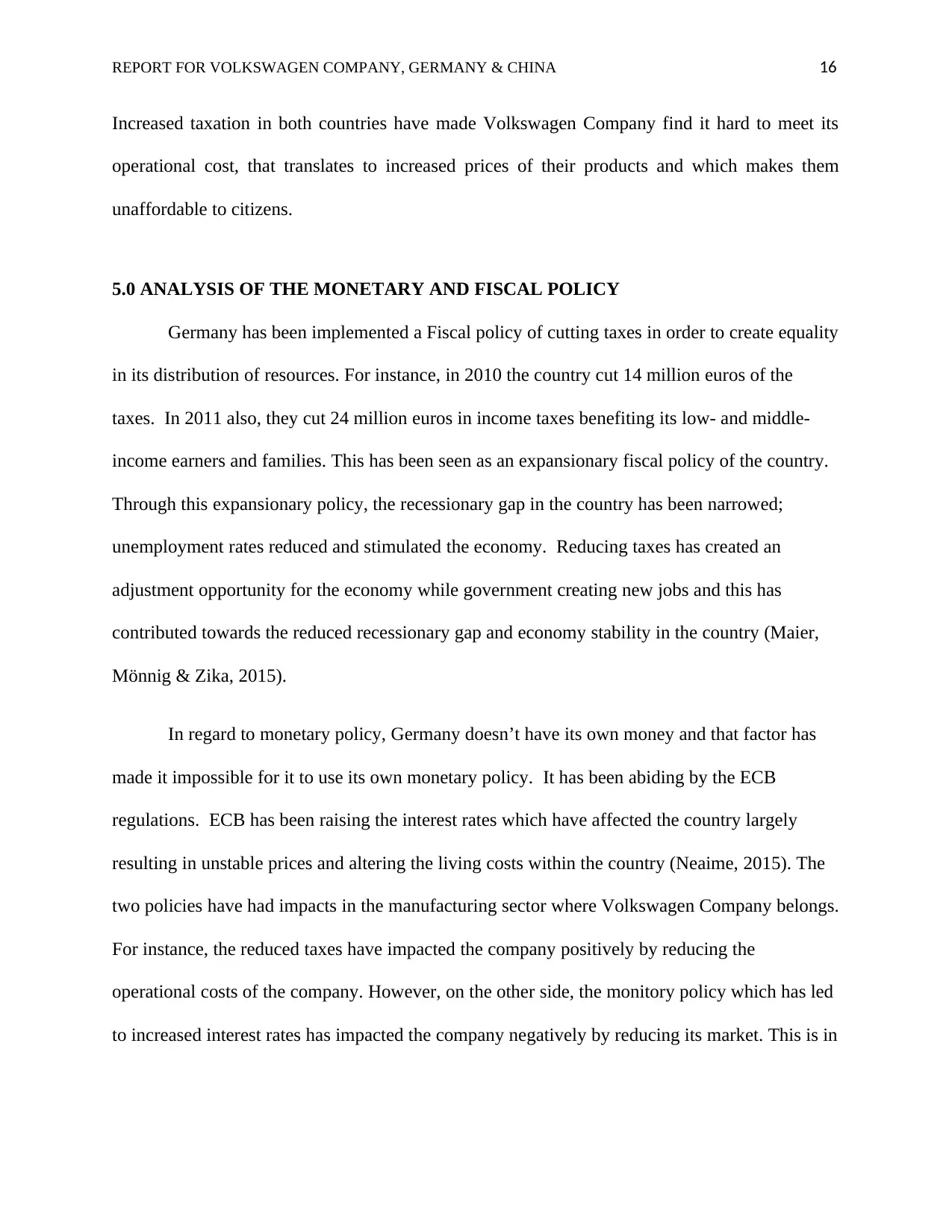
REPORT FOR VOLKSWAGEN COMPANY, GERMANY & CHINA 16
Increased taxation in both countries have made Volkswagen Company find it hard to meet its
operational cost, that translates to increased prices of their products and which makes them
unaffordable to citizens.
5.0 ANALYSIS OF THE MONETARY AND FISCAL POLICY
Germany has been implemented a Fiscal policy of cutting taxes in order to create equality
in its distribution of resources. For instance, in 2010 the country cut 14 million euros of the
taxes. In 2011 also, they cut 24 million euros in income taxes benefiting its low- and middle-
income earners and families. This has been seen as an expansionary fiscal policy of the country.
Through this expansionary policy, the recessionary gap in the country has been narrowed;
unemployment rates reduced and stimulated the economy. Reducing taxes has created an
adjustment opportunity for the economy while government creating new jobs and this has
contributed towards the reduced recessionary gap and economy stability in the country (Maier,
Mönnig & Zika, 2015).
In regard to monetary policy, Germany doesn’t have its own money and that factor has
made it impossible for it to use its own monetary policy. It has been abiding by the ECB
regulations. ECB has been raising the interest rates which have affected the country largely
resulting in unstable prices and altering the living costs within the country (Neaime, 2015). The
two policies have had impacts in the manufacturing sector where Volkswagen Company belongs.
For instance, the reduced taxes have impacted the company positively by reducing the
operational costs of the company. However, on the other side, the monitory policy which has led
to increased interest rates has impacted the company negatively by reducing its market. This is in
Increased taxation in both countries have made Volkswagen Company find it hard to meet its
operational cost, that translates to increased prices of their products and which makes them
unaffordable to citizens.
5.0 ANALYSIS OF THE MONETARY AND FISCAL POLICY
Germany has been implemented a Fiscal policy of cutting taxes in order to create equality
in its distribution of resources. For instance, in 2010 the country cut 14 million euros of the
taxes. In 2011 also, they cut 24 million euros in income taxes benefiting its low- and middle-
income earners and families. This has been seen as an expansionary fiscal policy of the country.
Through this expansionary policy, the recessionary gap in the country has been narrowed;
unemployment rates reduced and stimulated the economy. Reducing taxes has created an
adjustment opportunity for the economy while government creating new jobs and this has
contributed towards the reduced recessionary gap and economy stability in the country (Maier,
Mönnig & Zika, 2015).
In regard to monetary policy, Germany doesn’t have its own money and that factor has
made it impossible for it to use its own monetary policy. It has been abiding by the ECB
regulations. ECB has been raising the interest rates which have affected the country largely
resulting in unstable prices and altering the living costs within the country (Neaime, 2015). The
two policies have had impacts in the manufacturing sector where Volkswagen Company belongs.
For instance, the reduced taxes have impacted the company positively by reducing the
operational costs of the company. However, on the other side, the monitory policy which has led
to increased interest rates has impacted the company negatively by reducing its market. This is in
Secure Best Marks with AI Grader
Need help grading? Try our AI Grader for instant feedback on your assignments.
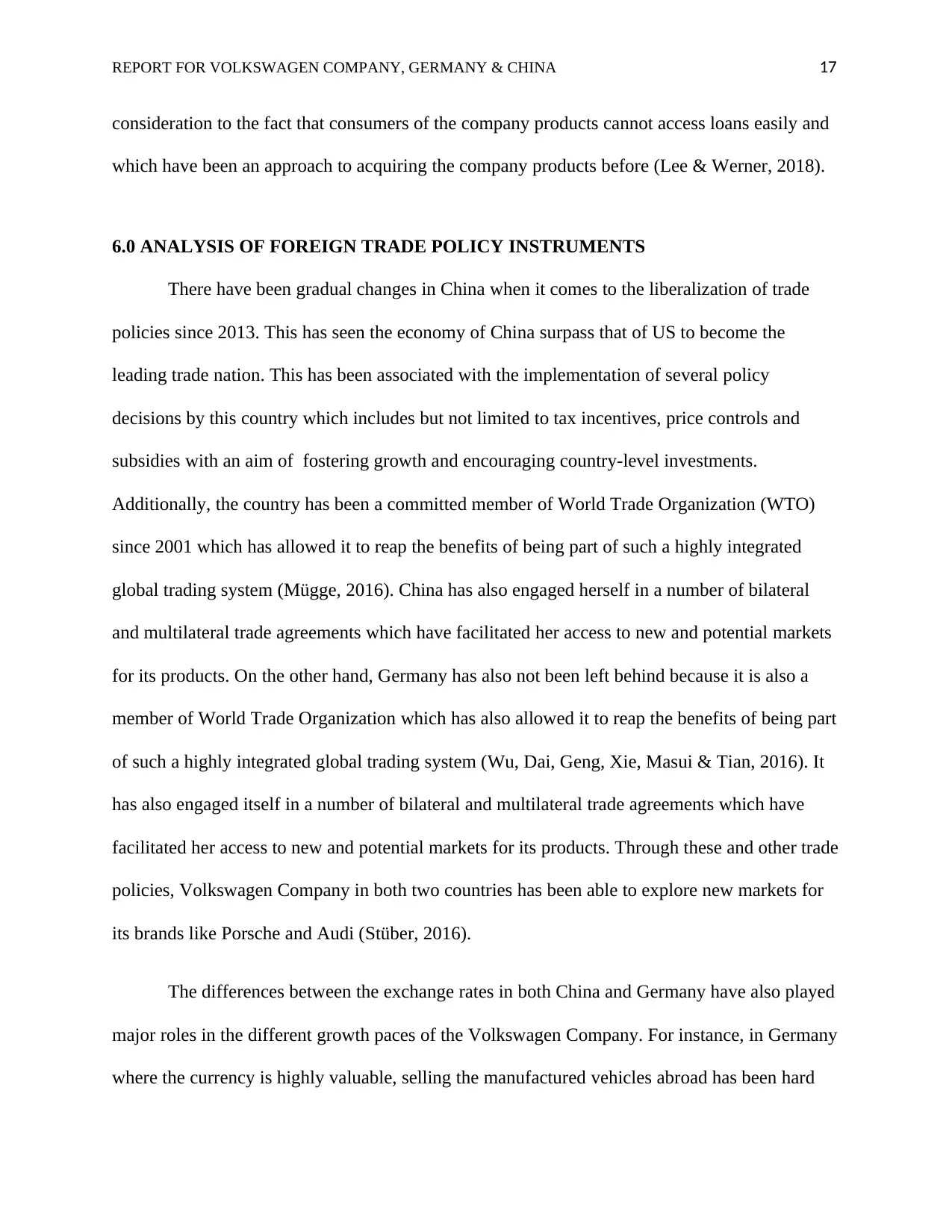
REPORT FOR VOLKSWAGEN COMPANY, GERMANY & CHINA 17
consideration to the fact that consumers of the company products cannot access loans easily and
which have been an approach to acquiring the company products before (Lee & Werner, 2018).
6.0 ANALYSIS OF FOREIGN TRADE POLICY INSTRUMENTS
There have been gradual changes in China when it comes to the liberalization of trade
policies since 2013. This has seen the economy of China surpass that of US to become the
leading trade nation. This has been associated with the implementation of several policy
decisions by this country which includes but not limited to tax incentives, price controls and
subsidies with an aim of fostering growth and encouraging country-level investments.
Additionally, the country has been a committed member of World Trade Organization (WTO)
since 2001 which has allowed it to reap the benefits of being part of such a highly integrated
global trading system (Mügge, 2016). China has also engaged herself in a number of bilateral
and multilateral trade agreements which have facilitated her access to new and potential markets
for its products. On the other hand, Germany has also not been left behind because it is also a
member of World Trade Organization which has also allowed it to reap the benefits of being part
of such a highly integrated global trading system (Wu, Dai, Geng, Xie, Masui & Tian, 2016). It
has also engaged itself in a number of bilateral and multilateral trade agreements which have
facilitated her access to new and potential markets for its products. Through these and other trade
policies, Volkswagen Company in both two countries has been able to explore new markets for
its brands like Porsche and Audi (Stüber, 2016).
The differences between the exchange rates in both China and Germany have also played
major roles in the different growth paces of the Volkswagen Company. For instance, in Germany
where the currency is highly valuable, selling the manufactured vehicles abroad has been hard
consideration to the fact that consumers of the company products cannot access loans easily and
which have been an approach to acquiring the company products before (Lee & Werner, 2018).
6.0 ANALYSIS OF FOREIGN TRADE POLICY INSTRUMENTS
There have been gradual changes in China when it comes to the liberalization of trade
policies since 2013. This has seen the economy of China surpass that of US to become the
leading trade nation. This has been associated with the implementation of several policy
decisions by this country which includes but not limited to tax incentives, price controls and
subsidies with an aim of fostering growth and encouraging country-level investments.
Additionally, the country has been a committed member of World Trade Organization (WTO)
since 2001 which has allowed it to reap the benefits of being part of such a highly integrated
global trading system (Mügge, 2016). China has also engaged herself in a number of bilateral
and multilateral trade agreements which have facilitated her access to new and potential markets
for its products. On the other hand, Germany has also not been left behind because it is also a
member of World Trade Organization which has also allowed it to reap the benefits of being part
of such a highly integrated global trading system (Wu, Dai, Geng, Xie, Masui & Tian, 2016). It
has also engaged itself in a number of bilateral and multilateral trade agreements which have
facilitated her access to new and potential markets for its products. Through these and other trade
policies, Volkswagen Company in both two countries has been able to explore new markets for
its brands like Porsche and Audi (Stüber, 2016).
The differences between the exchange rates in both China and Germany have also played
major roles in the different growth paces of the Volkswagen Company. For instance, in Germany
where the currency is highly valuable, selling the manufactured vehicles abroad has been hard
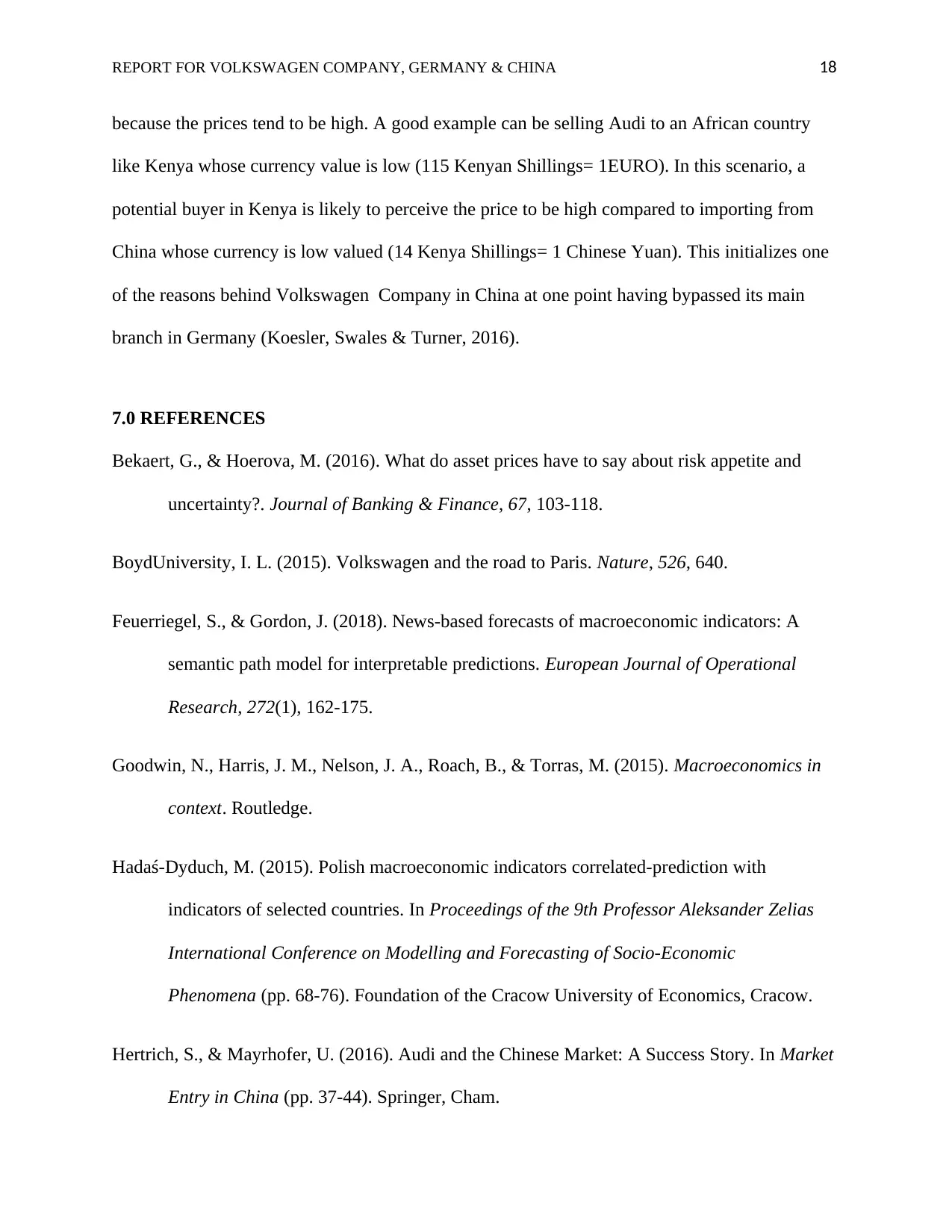
REPORT FOR VOLKSWAGEN COMPANY, GERMANY & CHINA 18
because the prices tend to be high. A good example can be selling Audi to an African country
like Kenya whose currency value is low (115 Kenyan Shillings= 1EURO). In this scenario, a
potential buyer in Kenya is likely to perceive the price to be high compared to importing from
China whose currency is low valued (14 Kenya Shillings= 1 Chinese Yuan). This initializes one
of the reasons behind Volkswagen Company in China at one point having bypassed its main
branch in Germany (Koesler, Swales & Turner, 2016).
7.0 REFERENCES
Bekaert, G., & Hoerova, M. (2016). What do asset prices have to say about risk appetite and
uncertainty?. Journal of Banking & Finance, 67, 103-118.
BoydUniversity, I. L. (2015). Volkswagen and the road to Paris. Nature, 526, 640.
Feuerriegel, S., & Gordon, J. (2018). News-based forecasts of macroeconomic indicators: A
semantic path model for interpretable predictions. European Journal of Operational
Research, 272(1), 162-175.
Goodwin, N., Harris, J. M., Nelson, J. A., Roach, B., & Torras, M. (2015). Macroeconomics in
context. Routledge.
Hadaś-Dyduch, M. (2015). Polish macroeconomic indicators correlated-prediction with
indicators of selected countries. In Proceedings of the 9th Professor Aleksander Zelias
International Conference on Modelling and Forecasting of Socio-Economic
Phenomena (pp. 68-76). Foundation of the Cracow University of Economics, Cracow.
Hertrich, S., & Mayrhofer, U. (2016). Audi and the Chinese Market: A Success Story. In Market
Entry in China (pp. 37-44). Springer, Cham.
because the prices tend to be high. A good example can be selling Audi to an African country
like Kenya whose currency value is low (115 Kenyan Shillings= 1EURO). In this scenario, a
potential buyer in Kenya is likely to perceive the price to be high compared to importing from
China whose currency is low valued (14 Kenya Shillings= 1 Chinese Yuan). This initializes one
of the reasons behind Volkswagen Company in China at one point having bypassed its main
branch in Germany (Koesler, Swales & Turner, 2016).
7.0 REFERENCES
Bekaert, G., & Hoerova, M. (2016). What do asset prices have to say about risk appetite and
uncertainty?. Journal of Banking & Finance, 67, 103-118.
BoydUniversity, I. L. (2015). Volkswagen and the road to Paris. Nature, 526, 640.
Feuerriegel, S., & Gordon, J. (2018). News-based forecasts of macroeconomic indicators: A
semantic path model for interpretable predictions. European Journal of Operational
Research, 272(1), 162-175.
Goodwin, N., Harris, J. M., Nelson, J. A., Roach, B., & Torras, M. (2015). Macroeconomics in
context. Routledge.
Hadaś-Dyduch, M. (2015). Polish macroeconomic indicators correlated-prediction with
indicators of selected countries. In Proceedings of the 9th Professor Aleksander Zelias
International Conference on Modelling and Forecasting of Socio-Economic
Phenomena (pp. 68-76). Foundation of the Cracow University of Economics, Cracow.
Hertrich, S., & Mayrhofer, U. (2016). Audi and the Chinese Market: A Success Story. In Market
Entry in China (pp. 37-44). Springer, Cham.

REPORT FOR VOLKSWAGEN COMPANY, GERMANY & CHINA 19
Kundnani, H. (2015). Leaving the west behind: Germany looks East. Foreign Aff., 94, 108.
Koesler, S., Swales, K., & Turner, K. (2016). International spillover and rebound effects from
increased energy efficiency in Germany. Energy economics, 54, 444-452.
Li, Z. (2018). Defining mega-platform strategies: the potential impacts of dynamic competition
in China. International Journal of Automotive Technology and Management, 18(2), 142-
159.
Lee, K. S., & Werner, R. A. (2018). Reconsidering monetary policy: An empirical examination
of the relationship between interest rates and nominal GDP growth in the US, UK,
Germany and Japan. Ecological Economics, 146, 26-34.
Maier, T., Mönnig, A., & Zika, G. (2015). Labor demand in Germany by industrial sector,
occupational field, and qualification until 2025–model calculations using the
IAB/INFORGE model. Economic Systems Research, 27(1), 19-42.
Mügge, D. (2016). Studying macroeconomic indicators as powerful ideas. Journal of European
Public Policy, 23(3), 410-427.
Mügge, D. (2015). Fickle Formulas. Towards A Political Economy of Macroeconomic
Indicators. Draft research agenda article presented at Brown University, 5.
Neaime, S. (2015). Sustainability of budget deficits and public debts in selected European Union
countries. The Journal of Economic Asymmetries, 12(1), 1-21.
Pang, K., & Siklos, P. L. (2016). Macroeconomic consequences of the real-financial nexus:
Imbalances and spillovers between China and the US. Journal of International Money
and Finance, 65, 195-212.
Kundnani, H. (2015). Leaving the west behind: Germany looks East. Foreign Aff., 94, 108.
Koesler, S., Swales, K., & Turner, K. (2016). International spillover and rebound effects from
increased energy efficiency in Germany. Energy economics, 54, 444-452.
Li, Z. (2018). Defining mega-platform strategies: the potential impacts of dynamic competition
in China. International Journal of Automotive Technology and Management, 18(2), 142-
159.
Lee, K. S., & Werner, R. A. (2018). Reconsidering monetary policy: An empirical examination
of the relationship between interest rates and nominal GDP growth in the US, UK,
Germany and Japan. Ecological Economics, 146, 26-34.
Maier, T., Mönnig, A., & Zika, G. (2015). Labor demand in Germany by industrial sector,
occupational field, and qualification until 2025–model calculations using the
IAB/INFORGE model. Economic Systems Research, 27(1), 19-42.
Mügge, D. (2016). Studying macroeconomic indicators as powerful ideas. Journal of European
Public Policy, 23(3), 410-427.
Mügge, D. (2015). Fickle Formulas. Towards A Political Economy of Macroeconomic
Indicators. Draft research agenda article presented at Brown University, 5.
Neaime, S. (2015). Sustainability of budget deficits and public debts in selected European Union
countries. The Journal of Economic Asymmetries, 12(1), 1-21.
Pang, K., & Siklos, P. L. (2016). Macroeconomic consequences of the real-financial nexus:
Imbalances and spillovers between China and the US. Journal of International Money
and Finance, 65, 195-212.
Paraphrase This Document
Need a fresh take? Get an instant paraphrase of this document with our AI Paraphraser
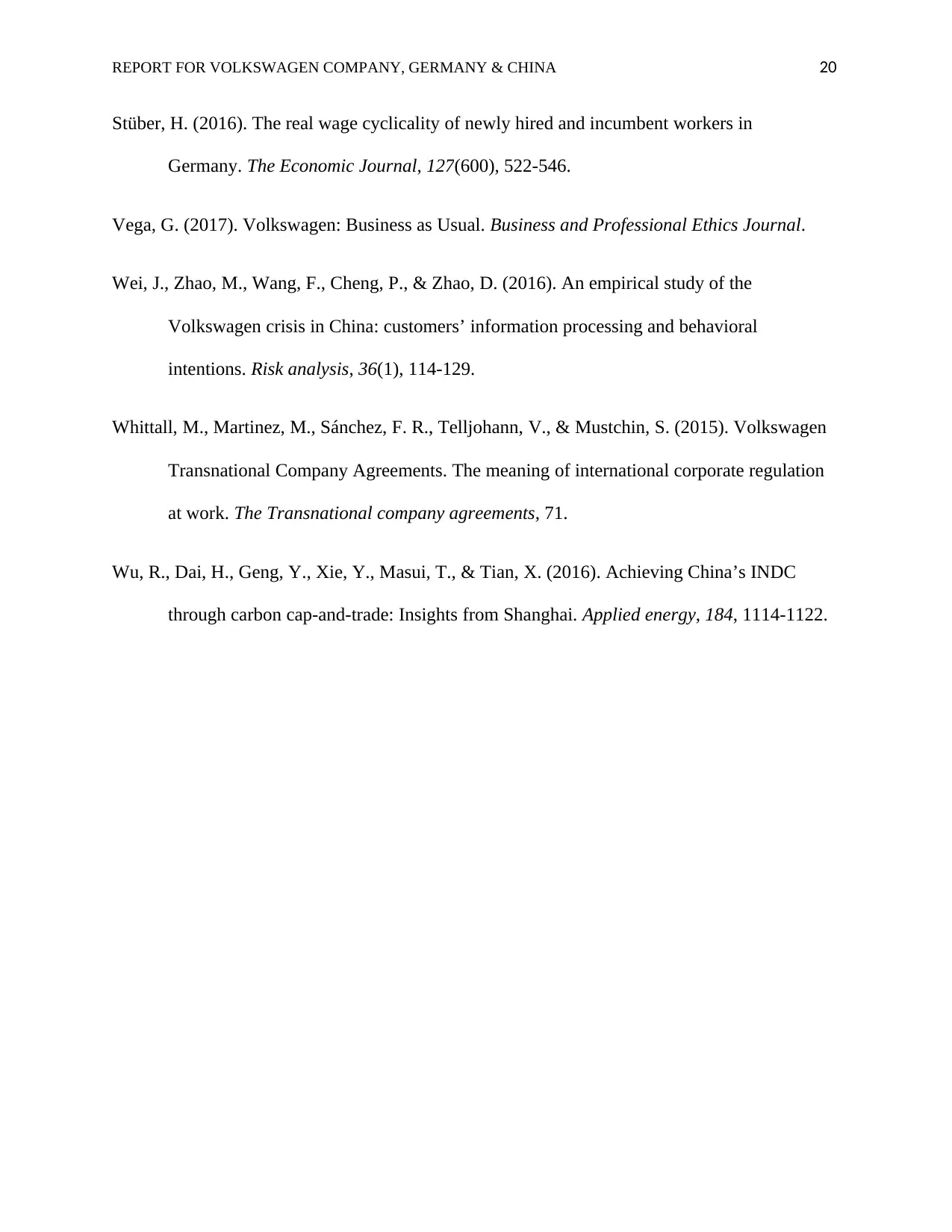
REPORT FOR VOLKSWAGEN COMPANY, GERMANY & CHINA 20
Stüber, H. (2016). The real wage cyclicality of newly hired and incumbent workers in
Germany. The Economic Journal, 127(600), 522-546.
Vega, G. (2017). Volkswagen: Business as Usual. Business and Professional Ethics Journal.
Wei, J., Zhao, M., Wang, F., Cheng, P., & Zhao, D. (2016). An empirical study of the
Volkswagen crisis in China: customers’ information processing and behavioral
intentions. Risk analysis, 36(1), 114-129.
Whittall, M., Martinez, M., Sánchez, F. R., Telljohann, V., & Mustchin, S. (2015). Volkswagen
Transnational Company Agreements. The meaning of international corporate regulation
at work. The Transnational company agreements, 71.
Wu, R., Dai, H., Geng, Y., Xie, Y., Masui, T., & Tian, X. (2016). Achieving China’s INDC
through carbon cap-and-trade: Insights from Shanghai. Applied energy, 184, 1114-1122.
Stüber, H. (2016). The real wage cyclicality of newly hired and incumbent workers in
Germany. The Economic Journal, 127(600), 522-546.
Vega, G. (2017). Volkswagen: Business as Usual. Business and Professional Ethics Journal.
Wei, J., Zhao, M., Wang, F., Cheng, P., & Zhao, D. (2016). An empirical study of the
Volkswagen crisis in China: customers’ information processing and behavioral
intentions. Risk analysis, 36(1), 114-129.
Whittall, M., Martinez, M., Sánchez, F. R., Telljohann, V., & Mustchin, S. (2015). Volkswagen
Transnational Company Agreements. The meaning of international corporate regulation
at work. The Transnational company agreements, 71.
Wu, R., Dai, H., Geng, Y., Xie, Y., Masui, T., & Tian, X. (2016). Achieving China’s INDC
through carbon cap-and-trade: Insights from Shanghai. Applied energy, 184, 1114-1122.
1 out of 20
Related Documents
Your All-in-One AI-Powered Toolkit for Academic Success.
+13062052269
info@desklib.com
Available 24*7 on WhatsApp / Email
![[object Object]](/_next/static/media/star-bottom.7253800d.svg)
Unlock your academic potential
© 2024 | Zucol Services PVT LTD | All rights reserved.





